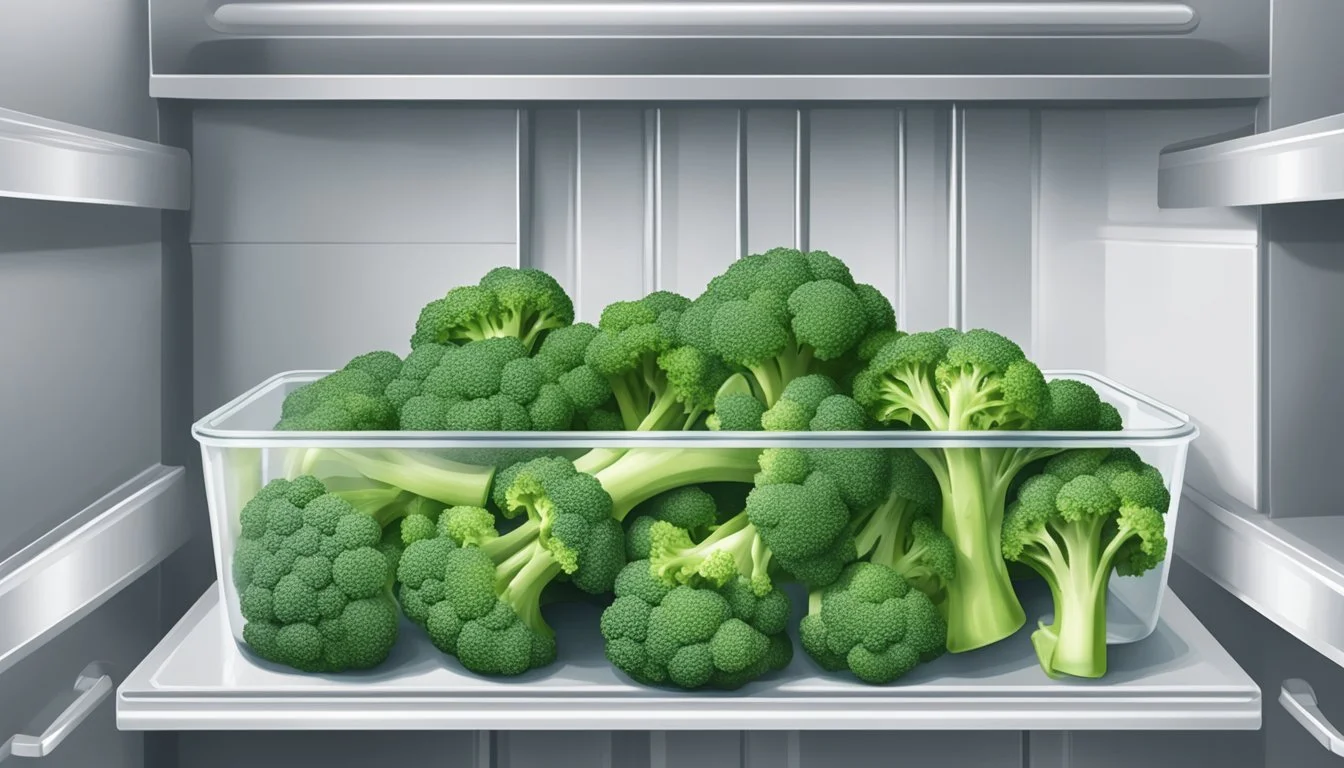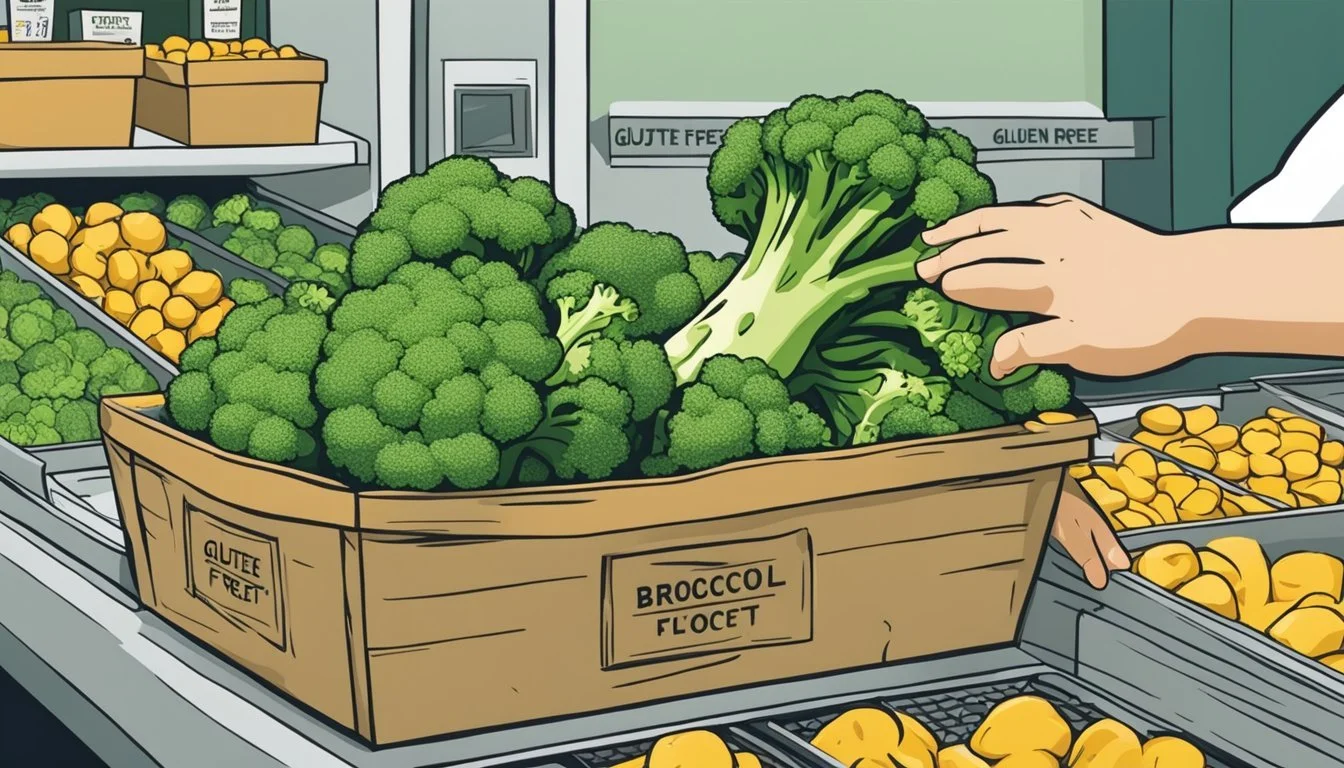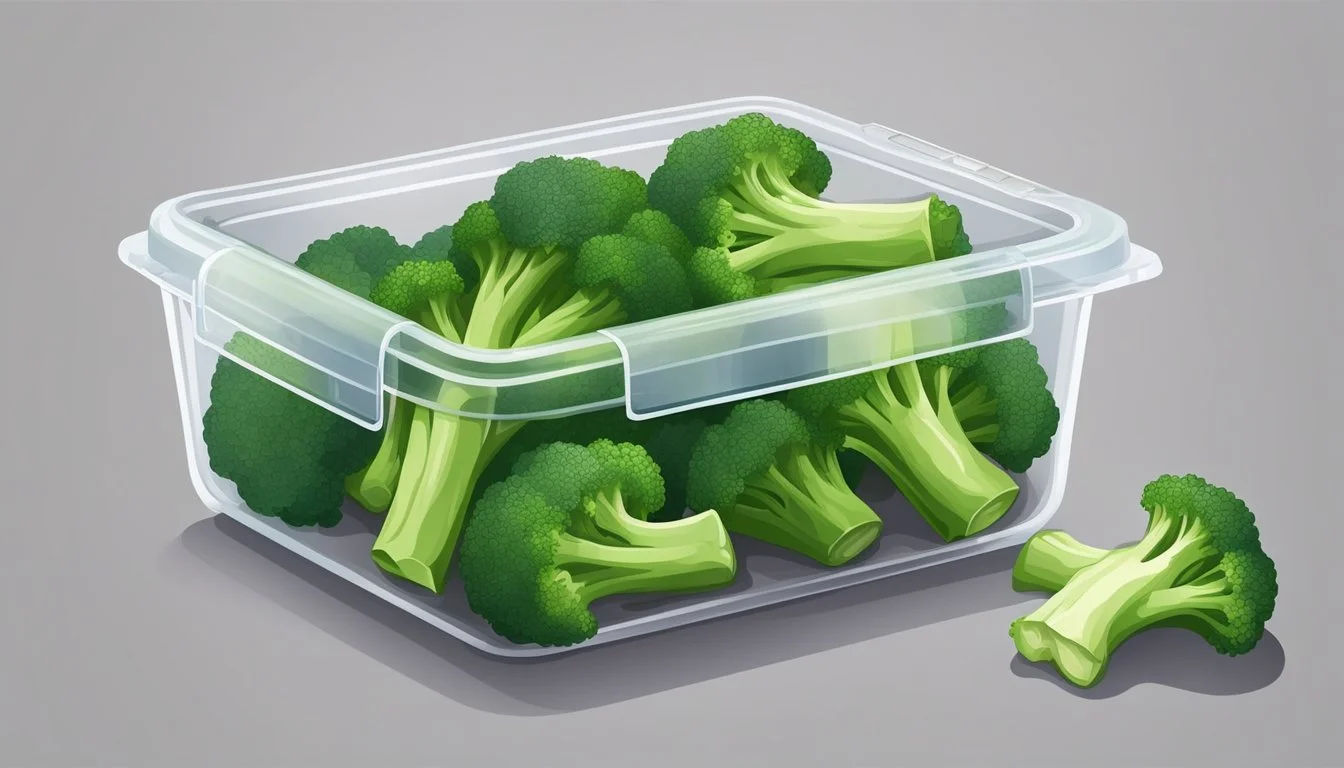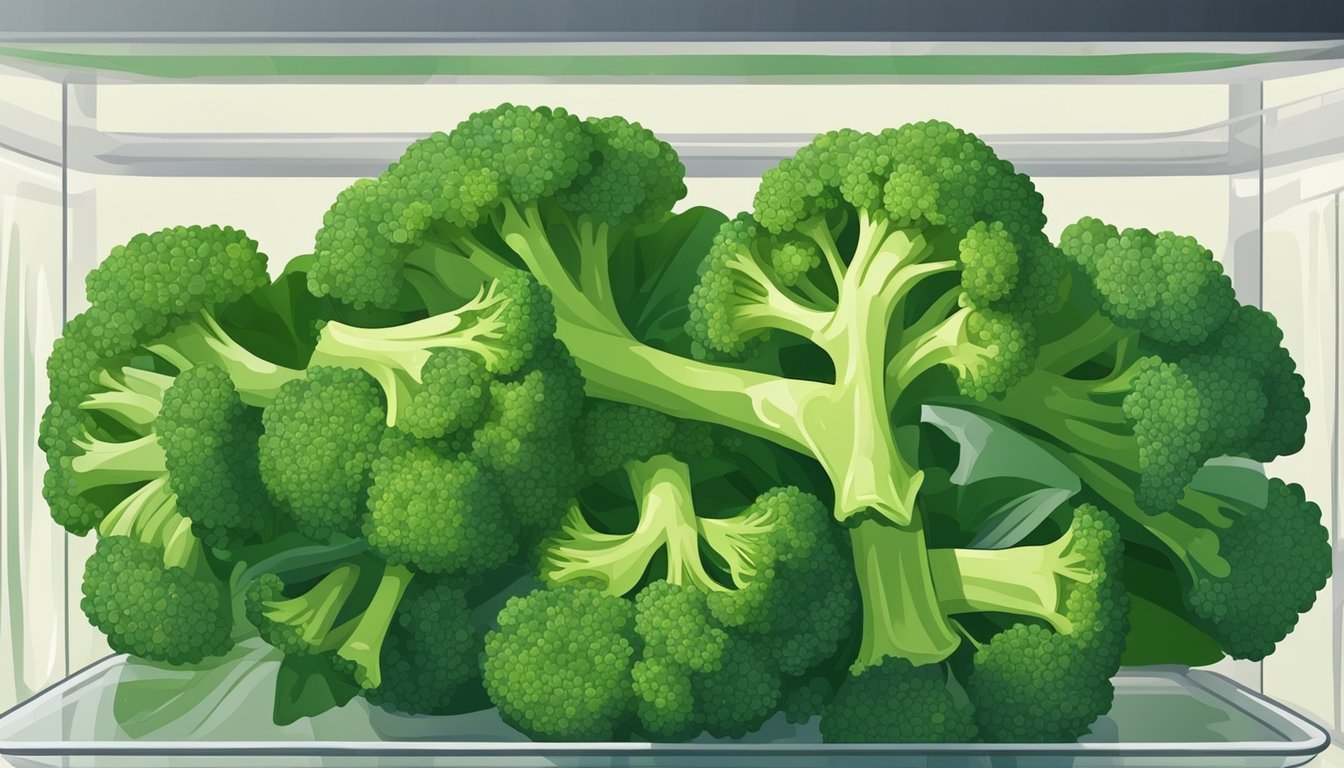How Long Do Gluten-Free Broccoli Florets Last?
Storage Tips and Shelf Life
Storing gluten-free broccoli florets correctly is essential for maintaining their freshness and flavor. Broccoli can be a key ingredient in a gluten-free diet, offering a nutritious boost to various meals. Fresh broccoli florets typically last 4 to 7 days when stored in the refrigerator, but their quality might decline rapidly after that period.
For those wanting to extend the shelf life of their broccoli, freezing is an effective method. Properly prepared and frozen broccoli florets can maintain their quality for several months. Whether you store them in the fridge or freezer, ensuring the florets are dry and stored in airtight containers or freezer-safe bags helps retain their freshness.
Cooked broccoli lasts slightly less time in the fridge, maintaining quality for 3 to 5 days. Therefore, knowing the proper storage techniques and time frames for both fresh and cooked broccoli helps prevent waste and ensures you always have this versatile vegetable ready for your gluten-free meals.
Overview of Gluten-Free Broccoli Florets
Broccoli is a highly nutritious vegetable that is naturally gluten-free. It plays a crucial role in a balanced, nutrient-rich diet, particularly for those who avoid gluten.
Nutritional Value of Broccoli
Broccoli is well-known for its dense nutrient profile. It is rich in vitamin C, vitamin A, fiber, and iron. A single cup of broccoli provides nearly all the daily recommended intake of vitamin C, which supports immune health and skin vitality.
Another important nutrient in broccoli is calcium, which is vital for bone health. Broccoli is also low in carbohydrates, making it a good option for those following a low-carb diet. Additionally, it provides a moderate amount of protein, contributing to muscle maintenance and repair.
Here’s a breakdown of broccoli’s key nutrients:
Nutrient Amount per Cup % Daily Value Vitamin C 81 mg 135% Vitamin A 567 IU 11% Fiber 2.3 g 9% Iron 0.7 mg 4% Calcium 43 mg 4%
Gluten-Free Eating and Broccoli
For individuals on a gluten-free diet, broccoli is an excellent addition. Being naturally free from gluten, it is safe for those with celiac disease or gluten sensitivity. Unlike many processed foods, fresh broccoli does not require any special processing to remove gluten.
Using broccoli in various dishes can also help diversify a gluten-free diet. It can be included in soups, stir-fries, salads, and casseroles. This versatile vegetable ensures that individuals can enjoy both health benefits and culinary variety.
In conclusion, broccoli is a nutritious, gluten-free vegetable that fits well into various dietary preferences.
Selecting and Buying Fresh Broccoli
Choosing the best broccoli is crucial to ensuring it stays fresh and lasts longer. Key factors include appearance, texture, and where you buy it.
Identifying Freshness
When selecting broccoli, look for firm and green florets. Avoid broccoli that has yellowing or browning, as this indicates age. The stems should be firm and not slimy or soft.
Ensure there are no black or mushy spots.
Fresh broccoli should have a vibrant green color and a firm texture.
Touch is essential. Fresh broccoli should feel dense when held. The stalk should snap easily when bent, indicating it is fresh and crisp.
Where to Buy Fresh Broccoli
Purchasing broccoli from a reliable grocery store or farmer's market can make a difference in its shelf life. Stores that have a high turnover of cruciferous vegetables ensure fresher produce.
Consider organic options where possible, as they often follow stricter guidelines for freshness.
Buying local can also be beneficial, as the time between harvest and sale is typically shorter. This means the broccoli is fresher when you purchase it.
Storing Broccoli Florets
Proper storage of broccoli florets ensures they stay fresh and retain their nutritional value. There are two main methods for storing broccoli florets: refrigeration and freezing.
Refrigerator Storage Techniques
To store broccoli florets in the refrigerator, start by preparing the florets using some key steps. First, arrange them on a kitchen towel to remove any excess moisture. This helps prevent mold and decay.
Next, use an airtight container or a zip-top plastic bag. The container should be clean and dry. Place the broccoli florets inside, ensuring to leave a little room for air circulation.
For the best results, store the florets in the crisper drawer of the fridge. This helps maintain optimal humidity, keeping them fresher longer. Under these conditions, broccoli florets can last around 3-5 days.
Freezing and Blanching Methods
Freezing broccoli florets involves a couple of key steps. Start by blanching the florets: boil them in salted water for about 2-3 minutes until they turn bright green. Immediately transfer the florets to a bowl of ice water to halt the cooking process, then drain and dry them.
Arrange the dry florets on a sheet pan in a single layer and freeze until solid, around 1-2 hours. After they are frozen, transfer them to a freezer-safe bag, ensuring to remove as much air as possible before sealing.
Label the bags with the date of freezing to keep track. When stored this way, broccoli florets can last up to a year in the freezer.
Both methods help preserve the quality and taste of broccoli florets efficiently.
Shelf Life and Signs of Spoilage
Gluten-free broccoli florets, like other fresh vegetables, have a limited shelf life and show specific signs when they begin to spoil. Proper storage is essential to maintain their freshness and avoid spoilage.
Typical Shelf Life of Broccoli Florets
At room temperature, broccoli florets typically last about 1 to 2 days before they start to decay.
When refrigerated, their shelf life extends to about 5 to 7 days, assuming they are stored in a plastic bag or container. If the broccoli has been blanched and then frozen, it can last for several months.
The shelf life can be affected by the freshness of the broccoli at the time of purchase and the conditions of storage. Keeping the broccoli dry and in a cool environment prolongs its life.
Indicators of Broccoli Going Bad
Several signs indicate that broccoli florets are spoiling. Visual cues include yellow or brown spots appearing on the florets.
The broccoli may also develop small patches of mold. The texture changes as well; it can become soft and limp instead of firm and crisp.
Smell is another indicator—spoiled broccoli will emit a strong, off-putting odor, different from the fresh, mild scent of good broccoli. Detecting any of these signs suggests that the broccoli is no longer safe to eat.
Preparing and Cooking Methods
Different techniques can affect how long gluten-free broccoli florets last. Each method—from basic to innovative—impacts the texture, flavor, and shelf life of the florets.
Basic Cooking Techniques
When boiling broccoli florets, start by cleaning them thoroughly and separating the florets from the stems. Fill a pot with water, bring it to a boil, and cook the florets for about 3 to 4 minutes until they are bright green and tender-crisp. Steaming is another common method. Use a steamer basket and steam the florets for 4-5 minutes.
Microwaving is also an option. Place the florets in a microwave-safe dish with a small amount of water, cover, and microwave on high for 4-6 minutes.
Innovative Broccoli Recipes
Roasting broccoli in the oven brings out a unique flavor. Preheat the oven to 400°F, toss the florets with olive oil, salt, and pepper, and bake for 15-20 minutes. Another interesting method is pressure cooking. Add the florets to the pressure cooker with a small amount of water and cook on high pressure for 1-2 minutes.
For a creative twist, try sheet pan recipes like smashed broccoli. After steaming, flatten the florets with a spatula, arrange them on a baking sheet, and roast until crispy.
Enhancing Broccoli Flavor
To elevate the taste of broccoli, one can use a variety of seasonings, condiments, and combinations with other ingredients. This approach transforms the simple vegetable into a flavorful and satisfying dish.
Seasonings and Condiments
Salt and pepper form the basic seasoning that enhances the natural flavor of broccoli. For a richer taste, adding garlic or garlic powder can make a significant impact.
Lemon juice adds a zesty brightness that complements the broccoli's earthy tones. Butter or olive oil can provide a smooth, creamy texture. For those who enjoy a bit of heat, a sprinkle of red pepper flakes can add a spicy kick.
Parmesan cheese is another excellent addition, offering a savory, umami flavor. Experimenting with these seasonings and condiments enables one to enhance broccoli in various delectable ways.
Combining Broccoli with Other Ingredients
Pairing broccoli with other ingredients amplifies its taste. Cheese, such as cheddar or mozzarella, can be melted over broccoli, creating a comforting and rich dish.
Incorporating bacon introduces a smoky and salty flavor that contrasts beautifully with the mild taste of broccoli. Mixing in roasted garlic or caramelized onions can add depth and complexity to the dish.
Additionally, broccoli can be combined with nuts, such as almonds or pine nuts, for a crunch. Adding cream or a creamy sauce creates a luxurious texture and taste. These combinations not only enhance flavor but also provide varied textures and experiences.
Health Benefits and Dietary Considerations
Broccoli florets are a nutritious and versatile food choice. They offer several health benefits and are suitable for a variety of dietary needs.
Dietary Impact of Broccoli
Broccoli is rich in essential nutrients. One cup (91 grams) of raw, chopped broccoli provides approximately 31 calories, 6 grams of carbohydrates, and 2 grams of dietary fiber. It contains trace amounts of fat and no cholesterol, making it a low-calorie, heart-healthy vegetable.
The high levels of vitamins C and K, folate, and sulforaphane in broccoli contribute to its health benefits. Vitamin C helps boost the immune system, while vitamin K is crucial for bone health and blood clotting. Folate supports cell function and tissue growth, and sulforaphane is associated with cancer prevention.
Broccoli also has notable amounts of potassium, which can help manage blood pressure levels. Including broccoli in a gluten-free diet can contribute to better overall health without adding unnecessary calories or sodium.
Serving and Presentation Tips
Serving broccoli florets as a gluten-free dish can be both appealing and practical. Focus on enhancing flavor and selecting the proper equipment to showcase your broccoli side dish effectively.
Creating a Flavorful Side Dish
To create a flavorful side dish, consider seasoning broccoli with lemon juice, garlic oil, and fresh herbs like dill and parsley. These ingredients not only enhance the broccoli's taste but also add visual appeal.
For added texture, roast the broccoli alongside potatoes. This combination provides a balance of flavors and makes for a satisfying accompanying dish. Use a high-temperature roast to achieve a crispy exterior while maintaining a tender inside.
Another option is to steam the broccoli and then drizzle it with a garlic-lemon vinaigrette. Steaming preserves the broccoli’s bright green color and essential nutrients. A sprinkle of parmesan cheese or toasted almonds can also elevate the dish, offering an appealing contrast in texture and flavor.
Appropriate Serving Equipment
Choosing the right equipment is crucial for both preparation and presentation. Start with a large baking sheet lined with parchment paper if roasting. This setup ensures even cooking and easy cleanup.
For steaming, use a steamer basket inside a pot with a lid. This method keeps the florets tender while preventing them from becoming waterlogged.
When it comes to presentation, a shallow serving dish or a wooden board can make the broccoli side dish more inviting. Garnish with fresh herbs or lemon wedges to add a pop of color.
Placing the dish on a neutral-colored platter can make the vibrant green broccoli stand out. Use tongs or a large serving spoon to serve, which can help maintain the integrity of the florets.
Following these tips will enhance the dining experience with a visually appealing and delicious gluten-free broccoli side dish.
Usage in Special Diets
Broccoli florets are versatile in various special diets, such as gluten-free, dairy-free, and paleo. Their nutritional value makes them a popular choice among health-conscious individuals.
Broccoli in Gluten-Free Cooking
Broccoli is naturally gluten-free, making it ideal for gluten-free diets. It can be used in a variety of dishes, including salads, soups, and casseroles. Due to its rich fiber content, it helps in digestion and provides satiety, which is beneficial for individuals managing celiac disease or gluten sensitivity.
Broccoli’s antioxidants and vitamins also support overall health. When incorporating broccoli into gluten-free meals, consider combining it with other nutritious, gluten-free ingredients like quinoa or lentils. These combinations not only enhance taste but also boost nutritional value, offering a well-rounded diet.
Broccoli in Dairy-Free and Paleo Diets
In dairy-free diets, broccoli serves as an excellent source of calcium and vitamin K, both essential for bone health. It’s a great alternative to dairy products, ensuring individuals still receive necessary nutrients. Broccoli can be steamed, roasted, or even pureed into dairy-free sauces and soups.
For those following a paleo diet, broccoli fits well due to its whole-food nature. It's packed with vitamins, minerals, and fiber, aligning perfectly with the paleo principles of eating nutrient-dense foods. Adding broccoli to paleo meals can enhance nutritional value while keeping the dishes fresh and diverse.
Preservation and Longevity Enhancements
Gluten-free broccoli florets, like any fresh produce, require proper methods to extend their shelf life.
Moisture Management
Moisture is a critical factor in preventing mold growth and bacteria. Use paper towels to remove excess moisture from the broccoli before storage.
Refrigeration
Store the broccoli florets in the refrigerator's vegetable crisper drawer at 0-4°C (32-39°F). This helps slow the growth of bacteria and extends freshness.
Blanching Method
Blanching can enhance preservation. Plunge the florets into boiling water for 2-3 minutes, then immediately transfer them to an ice-water bath. Once cooled, drain and pat them dry.
Freezing
Arrange blanched florets on a sheet pan in a single layer and freeze until solid (1-2 hours). Transfer them to a freezer-safe bag, remove excess air, and seal tightly.
Airtight Containers
Packing broccoli in airtight containers or vacuum-sealed bags can further prevent mold and bacteria growth.
Pressure Cooker
For long-term storage, cook florets in a pressure cooker to kill bacteria before freezing them in sealed containers.
Storage Lifespan
Raw whole broccoli: 7-14 days in the fridge
Raw cut broccoli: 4-5 days in the fridge
Cooked broccoli: 7-9 days in the fridge
Blanched and frozen broccoli: Up to 8-12 months
These methods ensure that broccoli florets remain fresh and safe to eat for as long as possible.
Resourceful Uses for Leftover Broccoli
Utilizing leftover broccoli efficiently can lead to delicious and creative meals. This section focuses on inventive ways to repurpose broccoli and specific meal ideas for future use.
Creative Leftover Ideas
Broccoli Cheese Soup: Transform leftover broccoli into a comforting, gluten-free broccoli cheese soup. Blend broccoli with gluten-free broth, add shredded cheese, and simmer until creamy.
Broccoli Fritters: Mix chopped broccoli, gluten-free flour, eggs, and spices to create fritter batter. Fry until golden brown for a tasty, crispy snack.
Broccoli Smoothie: For a nutritious start, blend broccoli with fruits like banana and apple, along with almond milk. It's an easy way to incorporate greens into your breakfast.
Broccoli-Based Meals for Next Day
Broccoli Stir Fry: Combine leftover broccoli with bell peppers, onions, and gluten-free soy sauce. Stir fry and serve over rice or quinoa for a quick lunch or dinner.
Broccoli and Cheese Casserole: Use broccoli in a gluten-free casserole. Mix it with a dairy-free cheese sauce, bake until bubbly and golden brown.
Broccoli Omelette: Make a healthy breakfast by adding chopped broccoli to an omelet. Pair it with cheese and spices to create a nutritious, gluten-free meal suitable for any time of the day.












